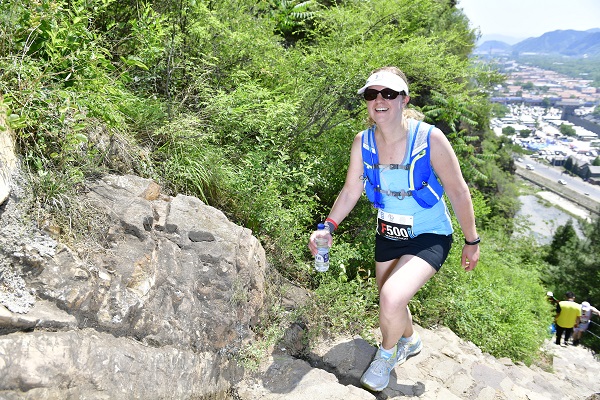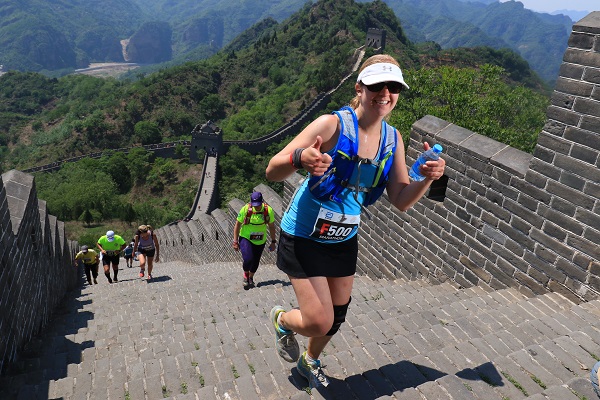
As I slowly dragged one foot in front of the other, I could feel my calf muscles strain and tighten. I was running on relatively flat ground, on black asphalt, but it felt like I was pushing myself uphill. I thought back to the prior few days – a five-hour walking tour around Beijing, an hour and a half “inspection” of the marathon course on the Great Wall and a way-too-long tour to the Qing Tombs that involved far more walking than I would have liked. Did I wear myself out? Was my Great Wall Marathon experience going to come to a crashing end before it ever really started?
After all, I had only just turned the corner coming out from the start line. I was hurting already and I still had 26 miles to go.

Luckily, my calves stopped burning by the time I started the continuous uphill climb toward the entrance to the Great Wall. It was this nearly five kilometer section of the race that worried me more than anything else as I was afraid the steep start would wear me out for the rest of the course. I had never run so far, so steep in the past. So I forced myself to take it nice and slow and set a mental goal of finishing the first five kilometers in about 45 minutes – far slower than my normal 5K time of around half an hour, but a steady pace that would keep me on track to make it back to the wall for the second time before the cut-off time of six hours.
And indeed, I made it to the wall under my goal, stopping to walk a couple times and passing a couple of South African men dressed in rhinoceros costumes along the way (who, after I saw them at the start line, I made it my goal to beat).

Since we had walked the approximately three-kilometer section of the wall two days earlier, I knew what to expect when I started up the steps to this ancient landmark. I had no choice but to take it slow as the path narrowed and numerous bottlenecks ensued. As we were able to spread out, I took the downhill sections as quickly as possible while continuing a steady pace for the steps going up. I had given myself about an hour and a half to finish this section of the race, but to my surprise I was off the wall in just 45 minutes – putting me well ahead of my projected pace and allowing me to relax as I started the long, flat section that led through the surrounding villages of Huangyaguan, Duanzhuang, Xiaying and Dongjiafen.


I got into a good rhythm, running at what felt like my normal marathon pace. I have no idea how fast I really ran, though, as my Garmin malfunctioned (when I passed the 16-mile marker, it said I was around 11 miles!). I passed schoolkids offering high-fives and stopped to take selfies with a few groups. One little girl shyly offered me a handful of wildflowers, so I took a selfie with her as well. Another boy had a notebook that he was extending to runners, prompting us to sign our names and countries for him before we continued. While the roads weren’t lined with the crowds of spectators like I was used to running in New York or Chicago, the enthusiasm and smiles of those who did come out to greet us were contagious. Despite the grueling nature of the race, I can’t remember having such fun while running.


For a while, I entertained the idea of making it to the halfway point in under three hours, but around the 15-kilometer point, another gradual uphill climb began and I started taking the occasional walking break again (around this time, I also saw a guy puking on the side of the road, making me realize I was really in good shape compared to some!). I made it to the halfway point in three hours and eight minutes – still well ahead of my goal. Doing the math in my head, I realized I had about 13 kilometers (eight miles) to cover to make it back to the wall for the second time. There was no question I could make that in three hours and I started to wonder if I could make it in two hours, which would put me a whole hour ahead of my goal! Even as the uphill grew steeper for a good bit and I slowed to a walk with everyone else, I knew that covering eight miles in two hours was completely realistic (running my normal marathon pace, I would cover that distance in about an hour and a half).
After the steep uphill sections in little shade, we were rewarded with a nice downhill stretch through Chedaoyu and Duanzhuang villages before returning to the main road that would lead us back to Yin and Yang Square and back up onto the wall.
The three kilometers or so back to Yin and Yang Square was a struggle. We were running alongside a fairly busy road, with traffic whizzing by on a regular basis. The road was at a slight incline and there was no shade and no water stations. And at one point, we had to cross the road, doing our best to avoid any traffic! On the plus side, there was a gas station that had toilets that were open, so I used that as my first opportunity to answer nature’s call.
As I entered Yin and Yang Square, I heard someone calling my name and turned to see Marcy, one of the girls from my tour group who had run the half marathon. That provided a nice, unexpected boost!
Finally, after five hours and 10 minutes, I made it back onto the wall, receiving a rubber wristband that would prove I had indeed run the wall twice. In many ways, this had been my goal all along as I was confident that if I made it back to the wall, I would definitely finish the race. To make it with nearly an hour to spare was an added bonus.
As I started up the steep path known as the Goat Track, I took a conservative approach, taking it ten steps at a time and then stopping for a quick rest and drink of water. I felt surprisingly good and seemed to be moving faster than most. I passed at least a dozen runners completely stopped on the Goat Track, struggling to continue at all. At one point, my left knee started to feel a bit sore so I stopped to put on my knee brace, hoping it would provide the extra support I would need to get by. Indeed, the downhill sections of the wall would prove to be the most challenging due to the strain on my knees and I used the strategy of going down them backwards to alleviate some of that stress even if it meant slowing down.


I completed the wall for the second time in just 15 minutes longer than it took me to run it the first time – not too shabby! And when I got off the wall, I knew that all I had left in front of me was about five kilometers, all downhill. I made another bathroom stop at the relatively nice toilets just off the wall (although still squat toilets, which are not fun after running 23 miles!) and then took off running. At this point, I knew I had a good chance of finishing in under seven hours and while my goal had once been solely to finish the race, I couldn’t resist the urge to finish in the best time possible (at one point I thought six and a half hours was possible, but the uphill sections in the villages dispelled that notion).
At the same time, the last two miles seemed to take forever and, once I passed a sign indicating I was just a half mile away from the finish line, that half a mile also seemed to take forever! But finally, six hours, 50 minutes and 56 seconds after I started, I crossed that finish line in Yin and Yang Square and received a very hard-earned medal! I was 543 of 876 who started the marathon, 189 of 356 female starters and 35 of 57 starters in my age group.

I realize this is already a crazy long post, but for anyone who may be thinking about running the Great Wall Marathon in the future, I want to share a few things I think helped me before and during the race:
Training – after completing a half marathon about two months before the race, I switched my training to focus on stairs, hills and strength training and less on running. I did one easy recovery run, one long run (up to a max of 20 miles) and one run of hill repeats each week and that was it for running. On top of that, I did a stair workout and a couple elliptical workouts, as well as 3-4 days of strength training, both lower body (squats, bridges, lunges, clamshells and other back/hip/core strengtheners) and upper body.
Nutrition – because I have Celiac and I knew gluten free food would be hard to come by in China, I brought a ton of my own food. But after seeing what the hotel served for breakfast the morning of the race, I would have done so anyway. I brought gluten free bagels, packets of oatmeal, peanut butter, raisins and Gatorade packets from home and bought apples and bananas at the market in Jixian. Thus, I was able to eat my normal pre-marathon meal of two bagels and peanut butter, oatmeal with raisins and a banana. I also filled my Camelbak with Gatorade so I didn’t have to rely on the mystery energy drink that they would provide along the way. During the run, I grabbed a banana on three occasions and went through two packs of raisins I carried with me.
Familiarity with heat – even though I hadn’t been training in very warm conditions, I have experience running two prior marathons in 85-degree heat and I spent eight days last summer hiking about seven hours a day in temperatures close to 100. I think I handled the heat during the Great Wall Marathon well because my body remembered these prior experiences and because I knew how to deal with it. I stayed well hydrated and I used the wet sponges to cool myself down at just about every aid station that offered them.
Marathon experience – this was my eighth marathon overall, which I think gave me a strong mental edge throughout the race.
To sum it up, running the Great Wall Marathon was an incredible experience and one I would recommend to anyone. I even think I might want to do it again someday.
